The End and the Beginning of Human Planet
by Dale Templar, Series Producer
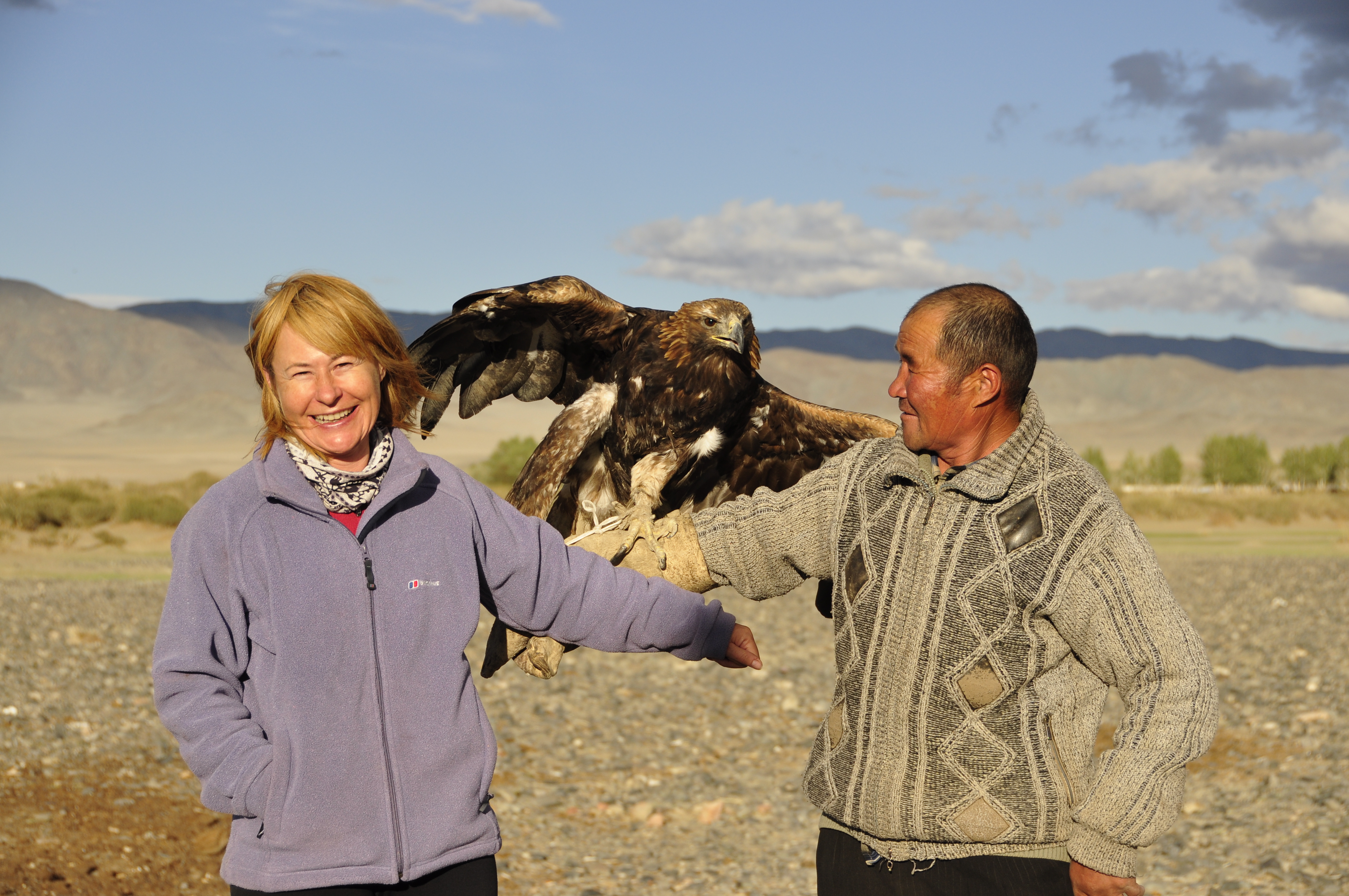
Dale pictured in Mongolia on a shoot to film the Eagle Hunters sequence from the Mountains programme.
Last Thursday saw the final episode of Human Planet transmit in the UK. I had mixed feelings as I watched the end credits roll for the last time. After three intense years, sending teams to over 70 locations including some of the remotest places on earth, this really did mark the end of the formal production process on the series. It is always sad when a production ends. Virtually all of my amazingly talent team have gone - many already on new adventures around the world. There is literally just a handful of us left in the Bristol and Cardiff offices.
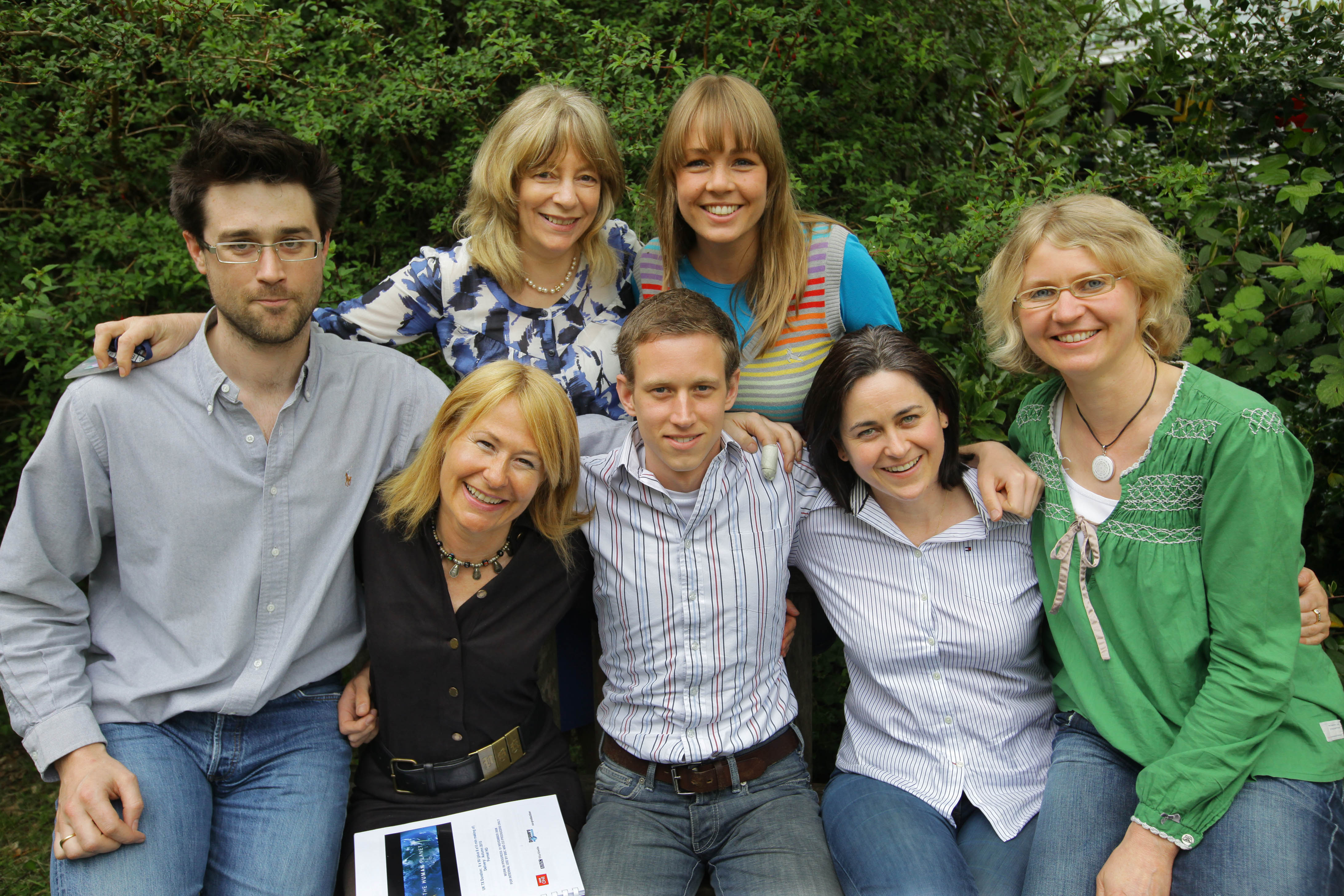
Dale with some of the Human Planet team. From left - right (front) Edit Assistant Craig Haywood, (Dale), Technical Co-ordinator Jasper Montana, Production Co-ordinator Isabelle Corr, Production Manager Alison Brown-Humes. (Back) Production Management Assistant Julia Wellard, Production Co-ordinator Jo Manley (Photo copyright Timothy Allen 2010)
But Human Planet has been different from any other programme I have ever worked on. Normally the last UK transmission would be the end of the series. For Human Planet it feels like a new beginning. For a start I am still in slight shock at the amazingly intense and positive reaction we have had to the series from people of all age groups. The series has been praised by members of the Royal Geographical Society, it’s been the focus of talk and gossip around office water coolers and it’s been making news particuarly online. I’m especially pleased that the series has connected with a younger audience - there’s been a buzz on Twitter and Facebook and millions of hits on You Tube. One young mum told me her 3 year old son was a huge fan of Human Planet, watching every episode without fail! No programme maker can ever be sure of a hit. This is a very fickle industry and audiences can never be guaranteed even when you’ve made a landmark series for the BBC. The feeling is that Human Planet is a fresh and different type of landmark. Many people, even those who don’t normally enjoy natural history have become hooked on humans!
Personally I hope this new found passion for humanity will continue. The series is a spectacular snapshot of the diverse human world we live in. But the world is changing fast, very fast. It’s becoming increasingly hermogenised. Even now one City looks much like the next - same Starbucks , same McDonald’s. Human Planet filmed with people who still directly depend on the natural world for their survival but their wisdom and customs may soon be disappear. The human species cannot be set in aspic but I think many of the stories we filmed will be gone within the next 10 years.
So what next? The series is now out on DVD/Blu-Ray and the book is in the shops. Next month it jumps across the Atlantic to be shown on Discovery Channel (a different version from the one showing in the UK) Then the UK version will start being shown on television around the world. So look out for Human Planet in your neck of the woods! Hopefully the BBC will commission a second series, watch this space…
So hopefully the end is truly just the beginning…I can only hope that this series sparks an interest in the challenges facing our human planet and that more is done to protect the incredible diversity, languages and cultures of our magnificent species.
Long live the Human Planet and all that sail on her!
15 Minutes of Fame Across the World
by Karina Moreton, Mongolian Fixer, Human Planet
The Human Planet series is made up of over 70 individal stories, each several minutes in length. As many of you will have gathered from the “Behind the Lens” snippets at the end of each episode, filming these sequences is never easy. Not only were there the challenges of the film crew – such as how to deal with ice melting; cliff edges and tides turning, there are the stories of the people portrayed. For some of them, the whirlwind of a film crew living with them was years ago now and they have gone about their daily lives since. Now that the series is out, will anything change for them?
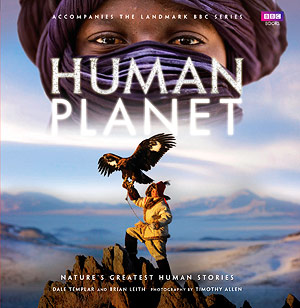
Berik from Human Planet's Mountains programme features on the book's cover
Berik from the Mountains programme is 16 years old. This is him and his eagle on the front of the book that accompanies the series. The book and programmes will be distributed worldwide and it’s hoped they will reach a huge audience. This is more than 15 minutes of fame! Around the world there is a culture of stardom – what would the teenagers from ‘Fame Academy’ and other talent shows give for this exposure? Some could worry that it might go to his head.
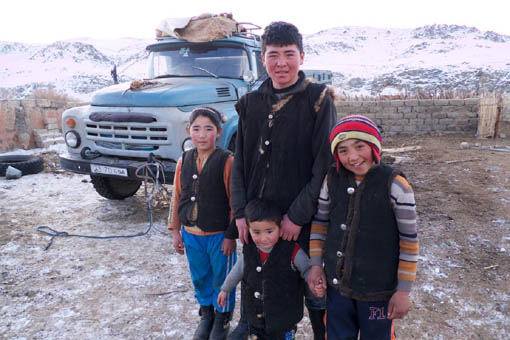
Berik with his cousins at his family home in Altansogts (image copyright Dina Mufti)
I’d like to show a photo or a clip of Berik looking at the book or DVD and giving his reactions. This however isn’t possible. Although copies of the book are on the way to Berik, they will take another 40 days to reach him. ’Outer’ Mongolia is considered to be the back of beyond, and Berik lives in one of the most remote parts of the country. I don’t anticipate that Berik will be exposed to his ‘fame’ until the next Eagle Festival.
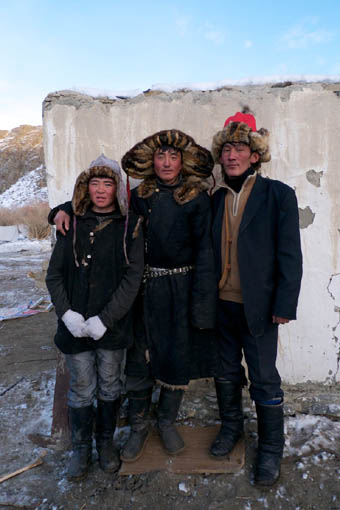
Berik with his older eagle hunting friends … before his first big hunt. (Image copyright Dina Mufti)
I think initially it will be the pages they feature in that will be the most thumbed through, though, with time, the other pages will be the ones that hold their attention. Over the last ten years of travelling through Mongolia, I have shown the reindeer herders of the north photographs of the camel herders in the south and I have shown young children photos of wolves and argali, animals that they have only dreamt of. Suddenly through this book, the Kazakh Eagle hunters of Mongolia are connected with not only the horse and camel breeders of central and southern Mongolia, but now they have shared an experience with the narwhal hunters of Greenland, mussel hunters of Canada and the honey gatherers of Nepal.
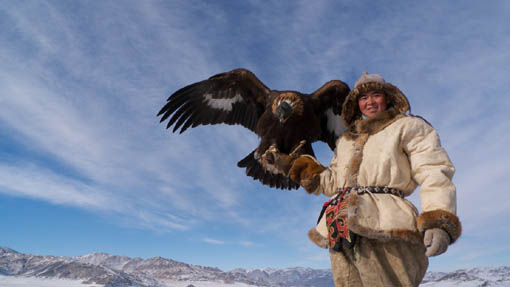
Berik, shortly after he catches his first fox …now officially a 'Kazakh man' (Image copyright Dina Mufti)
Mongolia is a landlocked country, so the images of the sea gypsies in the Pacific will no doubt enthral them. The bird of paradise hunter with his colourful headdress and nose piercing will amuse them. The naked Suri fighters will bemuse them. It is however I believe the story of the falconer in Dubai that will fascinate them. So much in common – for he also trains birds of prey to hunt, and yet they are in such a totally different world. Coming from a country with a rural population density of 0.9 people per square kilometre, it is almost inconceivable for a Mongolian to comprehend what it would be like to live in Dubai where there are 408 people per square kilometre.
Rural urban migration is a problem in Mongolia. Teenagers are attracted to the bright lights of the city. Berik might still be pulled away from his traditional way of life, but I think that perhaps the series will have changed the prospects for him and other young eagle hunters. By hosting occasional visitors who want to experience their culture first hand, this and other communities like them, have a renewed pride in what they do and a much-needed supplementary source of income.
After the characters in the Human Planet series have had their 15 minutes of fame, the book and the DVD will live on and spread their stories around the world. Many of the traditions and practises shown in the series may not survive until eternity.
Perhaps though, unknowingly, by exposing some of the characters to ‘others’ they may have slowed down the demise of man’s diversity?
Little Human Planet
by Elen Rhys, Producer, Little Human Planet
When delightful Dale Templar told me that Human Planet had been commissioned, my brain immediately started working overtime. Waw, what a great opportunity for a children’s spin off on CBeebies. Surely, if they would be filming humans in far flung and remote locations around the world, they were bound to be meeting children too. What a unique chance to work alongside this huge landmark commission to create something special for the BBC’s youngest viewers. And basically, that is how the CBeebies commission, Little Human Planet came to be.
Little Human Planet is a little sister series to Human Planet. It consists of 16 x 5 mins programmes that will be broadcast during the same period as the main series – but of course, at a time when 3-6 year olds are at their most attentive.
It’s a simple idea with a simple format. Each programme follows a typical activity in the life of a child from around the world – a glimpse to a CBeebies viewer of how their counterparts live, wherever they may be. On reflection, an unspoken celebration of what makes children different and what makes them the same in a colourful and often surprising voyage of discovery.
Unfortunately, I didn’t get to pack my passport to film the sequences. This was done by the brilliant Human Planet location teams. Yes, we liaised closely together regarding style and vision, understanding that certain things like nudity or blood and gore couldn’t be used. Naturally, this proved difficult in certain locations where few clothes, if any are worn and hunting for food is the norm. I was never sure what I was going to get, only crossing my fingers they would meet some children and film some magic moments . I’m used to having a bit more control, so this was quite difficult for me but I soon realised I needn’t have worried.
Each time a team came back with special Little Human Planet labelled footage it was like the anticipation and excitement of opening Christmas present. Who would, Dan Young, my editor and I meet this time? Could it be Dua, a six-year-old girl who lives in a tree house in a jungle in Papua or mischievous four-year-old, Carlos Eduardo, who lives on the flooded banks of the Rio Negro? Or how about four-year-old Shoree helping her dad build a ger home in Mongolia, or three-year-old Edjongon, who walks long distances each day to collect water from a well in Mali? Even though I have never met these fascinating characters, I feel as if I know them. And though the children’s experiences, circumstances and environments differ hugely, I learnt that at heart children are all the same and their smiles are universal.
Yet, paradoxes come to light. Without generalising, many of these children and families have very little, but yet, seem contented where community and sharing is a way of life. It taught me a lot and got me thinking..As a mum to a six-year-old, have we in the Western world lost our perspective ?
I am honoured, grateful and proud to be a tiny part of the Human Planet family and I hope there will be more opportunities like this in the future. If so, can I please come next time?
Dale Templar - Series Producer
Here’s hoping - Elen!
Little Human Planet is one of spin-offs programmes and extras that are part of the Human Planet . We have already had a post from our team at BBC, Radio Three working on Music Planet and in a few weeks we’ll have one from our BBC Learning team. They are using our footage to make programmes that will be used as teaching aids in scools.
Music Planet: Andy Kershaw Keeps His Head
by Roger Short, Producer, Music Planet , BBC Radio 3
In March this year, on his first trip for Music Planet, presenter Andy Kershaw visited the Solomon Islands. This was the most remote area either of us had ever been to, so we decided we really should find some people – and music – that were as far away from western culture, particularly the influence of the Christian missionaries, as possible. So we took a small plane to a grass runway on Malaita Island, drove in a truck for two hours, took a boat along the coast for an hour, and finally reached a village of the Kwaio people. Even here a church and a school awaited us. But after a three-hour steep trek up a mountain, we arrived at the remote Kwaio villages which still follow animist culture. They weren’t exactly geared up for visitors, so our team of five (including engineer James Birtwistle, plus local guide and interpreter) all slept together in a tiny hut on stilts. Dinner was a cauldron of boiled potatoes. Fortunately the music more than made up for it.
First we heard the music of the ‘gilo stones’ – two players with bamboo sticks in hands and feet, knocking them on smooth stones in complex rhythmic patterns that Steve Reich would be proud of. Then the head of the village sat in a circle with four other men, gently beating out a rhythm with sticks, and first humming, then chanting an epic song. They later told us it was about the murder of a former British Governor who had tried in vain to impose taxes on the Kwaio. Andy asked them if they were former head-hunters. They queried the word ‘former’ – ‘we do reserve the right’, the chief said, ‘if it became necessary…’ No further challenging questions were asked.
Dale Templar, Human Planet, Series Producer says:
I can’t wait to listen to “Music Planet”. It is the BBC Radio 3 sister series that will accompany “Human Planet” when it transmits in the UK early in 2011. The Music Planet” team have been travelling around the world recording music from people all the different environments we have been to on the main series but in some cases they have visited different tribes and groups of people.
The Musical Language of Human Planet
by Nitin Sawhney, Composer for Human Planet
Well… Life working on “The Human Planet” has been quite revelatory.
Since working on Human Planet I have been repeatedly astounded by images of
human resilience from around the globe… stunning visuals of men taking casual strolls on seabeds (without breathing apparatus!),
stick fighters, Arctic hunters and rainforest bridge builders have
filled my computer screen daily with inspiration.
As it is my job to score this wonderful 8-part series, I find myself
constantly suspended between disbelief at the possibilities of
environmental adaptation and exhilaration at the prospect of scoring
arguably the most profound documentary narrative ever broadcast.
Creating the musical vocabulary for such disparate programmes is no
easy feat, however. Besides attempting to musically express the arc
and nuances of each individual episode, it has been my task to also
find a cohesive musical language for the entire series as a whole.
Over the next few months I will be scoring and orchestrating epic
scenes for the National Orchestra of Wales, various specialist
musicians and singers and most importantly attempting to find the soul
of this beautiful tale of human determination.
Dale Templar, series producer, is acting as my guide and mentor over
this period, helping me to navigate my way around the individual needs of directors, the meticulous executive review process and that search
for motifs, ideas and a musical vocabulary worthy of such classic
scenes.
I will be updating you as I go, not only on all of this but also the
ongoing discussions over Human Planet – Live!
Cheers
Nitin
Where are the Fish?
by Rachael Kinley, Researcher, Oceans and Jungles team
Of the three months that I’ve been on location for Human Planet Oceans shoots, over half of this time has been spent waiting for fish to appear. Off the shores of three continents, from sunrise to sunset, we’ve searched the open seas desperately hoping for some ‘sign’ that they are on their way.
First it was waiting for migrating mullet in Mauritania. The idea was to film with the Imraguen people who inhabit the Bank D’Arguin National Park and fish the huge numbers of mullet that pass through their waters each year. Every day for two weeks we optimistically headed out to sea in the fishermen’s dhows, but the mullet never arrived. Was it the moon, the wind or the water temperature? We will probably never know but after much debate we reluctantly decided to call off the shoot.
Then we moved on to Laguna on the coast of southern Brazil to try again to film a similar story. It was hard to decide when was the best time to go as the local fishermen seemed to have wildly conflicting ideas of when the mullet season actually occurred. In the end we embarked on our trip in mid May and although at first it looked as if we were going to be unlucky for a second time, after spending three weeks on location we finally managed to film fishermen hauling in impressive numbers of fish.
OK, so we were successful, but it was touch and go for quite a while and I swore I would never go on another shoot that depended on fish turning up. But what do you know, this October I was off again on another wild fish chase. This time it was off the coast of Palawan in the Philippines, sailing for fourteen hours a day for seven days with deep sea diving fishermen desperate to land a big catch. Sitting out at sea on a boat in the tropics, overlooking palm tree fringed sandy beaches, is not the worst place in the world to be left in limbo, but after days on end of no filming opportunities and burning our budget, even paradise can lose its appeal. But as so often seems to be the case on Human Planet shoots, on the very last day we finally managed to net something spectacular enough to make the cut.
We had what we needed, but I was dismayed to hear that even this catch was half the size of those that the fishermen said they used to get. The problem was not that the people had been lying to us about when and where the fish come in, nor that they had lost their traditional skills, but that there are no longer plenty of fish in the sea. Although newspapers and documentaries such as End of the Line tell us that global fish stocks are declining, as we still see plenty of fish on our supermarket shelves, it is all too easy to ignore the warnings.
I myself was aware of the problem, but it was really brought home to me by witnessing first hand how barren the seas of the world have become. At first the persistent lack of fish on our shoots seemed little more than the annoying bad luck that can plague any film shoot, but talking to people whose lives and livelihoods depend on maritime resources, I have become increasingly aware that diminishing fish stocks are becoming a huge problem affecting millions, if not billions, of people around the world. Having seen just how hard the lives of some of these people are already, I hate to think how they will survive if the fish disappear altogether.
Dale Templar - Series Producer - Human Planet
Heartache for Haiti
About six months ago, I sent assistant producer Willow off to do a recce in Haiti. We were looking for a place to show the huge destructive force of hurricanes and Haiti is regularly caught in the path of the worst storms that sweep through the Caribbean. Ironically, we never filmed in Haiti; in the 2009 season the hurricanes chose other paths. It was a bitter-sweet failure for the series. Willow and I were both aware we’d wasted time and money but also felt secretly pleased that the people of Haiti had escaped yet more devastation and destruction for another year. We could never have imagined the cruel twist of fate that would hit them just months later. Of all the places on Earth for a earthquake of this magnitude to hit. On her trip , Willow was given an insight into the desperation, poverty and hopelessness faced by the majority of the Haitian population. Hours after the earthquake, she and I talked on the phone, both unable to take in the enormity of the disaster. She had been there, I had made films after the Kobe Earthquake in Japan and in Banda Ache following the Boxing Day Tsunami. The hearts of the Human Planet team go out to the people of Haiti. Maybe, just maybe, something good will come from this.
State of Play : a Dialogue
by Brian Leith, Executive Producer
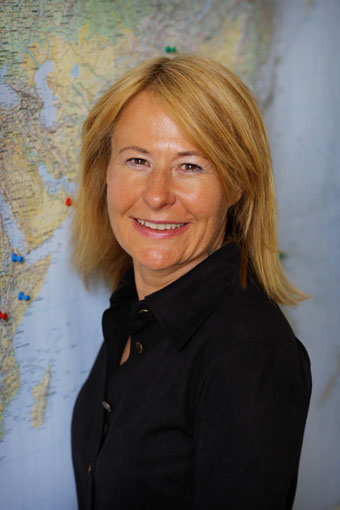 and Dale Templar, Series Producer
and Dale Templar, Series Producer
************************************************************
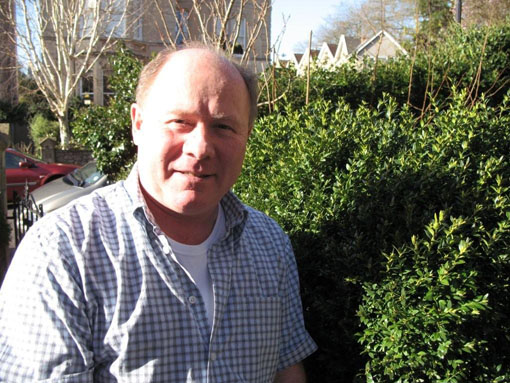 Well, 8 months to go now until we deliver the series. For many programmes, and most producers, this might seem like an eternity… But for us it seems like the day after tomorrow…
Well, 8 months to go now until we deliver the series. For many programmes, and most producers, this might seem like an eternity… But for us it seems like the day after tomorrow…
 Correction….It actually feels like tomorrow!
Correction….It actually feels like tomorrow!
When you start working on what we in TV land call a “landmark series”, a three year production cycle does feel like an eternity. For the first year it feels as if you are pushing a snowball up to the top of a hill. Year two and it starts rolling down, gradually building momentum and growing in size and now in year three the snowball is huge and rolling at speed with us all trying to keep it in control as it hurtles towards the finishing post! (I’ve used this metaphor because there are huge flakes of snow falling here in Cardiff and we’ve been working on the first edits of the Arctic episode). Over to you, Brian..
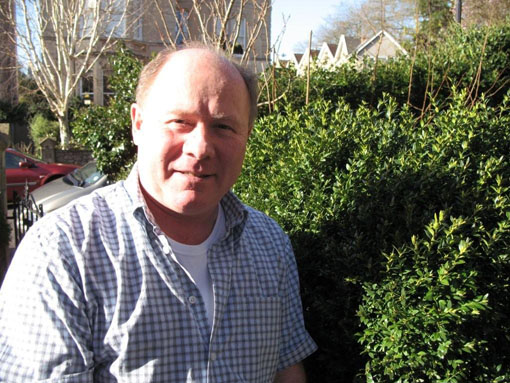 It feels like the Arctic here in Bristol too… it’s started snowing here as well, and the forecast is for heavy (ie traffic-stopping) snow today and tomorrow all over SW England and South Wales (several of us on the HP team were brought up in North America and we find it mildly pathetic, if amusing, how little snow seems to bring this mighty empire to its knees… in Montreal when I was a boy we’d get 6 inches of snow overnight and the snowploughs would be out clearing the roads before the sun rose. True!)
It feels like the Arctic here in Bristol too… it’s started snowing here as well, and the forecast is for heavy (ie traffic-stopping) snow today and tomorrow all over SW England and South Wales (several of us on the HP team were brought up in North America and we find it mildly pathetic, if amusing, how little snow seems to bring this mighty empire to its knees… in Montreal when I was a boy we’d get 6 inches of snow overnight and the snowploughs would be out clearing the roads before the sun rose. True!)
Gosh - apologies for that diversion!
Back to post-production, please, Dale: when do our edits start?
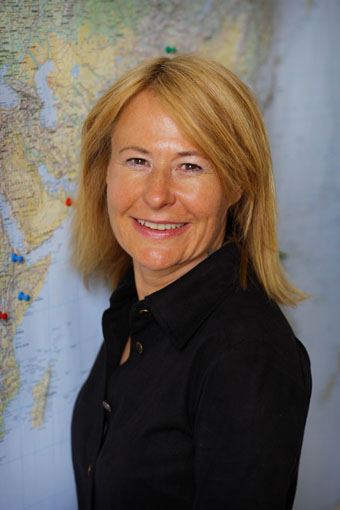 We go into edit in just a few weeks. Each hour of television takes ten or eleven weeks to cut. That includes the 10 minute “Making of”, where you get to see some of what goes on behind the cameras. After that we have several weeks of final post production or finishing which includes dubbing, mixing and voice-over plus the grade where the HD pictures really come to life. Many people get involved during this process, don’t they, Brian …..?.
We go into edit in just a few weeks. Each hour of television takes ten or eleven weeks to cut. That includes the 10 minute “Making of”, where you get to see some of what goes on behind the cameras. After that we have several weeks of final post production or finishing which includes dubbing, mixing and voice-over plus the grade where the HD pictures really come to life. Many people get involved during this process, don’t they, Brian …..?.
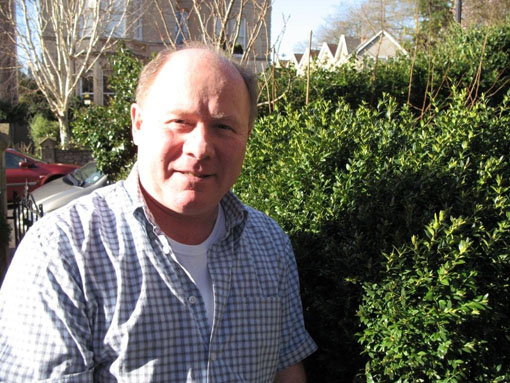 Ahem, cough splutter, yes indeed…
Ahem, cough splutter, yes indeed…
(Gee thanks Dale). Don’t get me wrong: we do need fresh eyes - to keep us pointing in the right direction, to make sure we’re making the programmes as strong as they can be. And it is easy to get so close to a programme that you can’t see the wood for the trees - so regular and constructive editorial feedback and guidance from well-informed senior execs is crucial…
But the reality is that it can get difficult. What if BBC wants a slightly different editorial angle from our other international co-production partners (who may have contributed just as much funding)? Who should we obey? What if someone new steps in to run the channel and they’re not as keen on the series as the previous controller? It has been known for new controllers to ‘kill the babies’ of previous incumbents – like male lions taking over a pride – in order to give their own offspring a better chance.
The truth is that the final approach to landing the finished series can be fraught with delays, disagreements and tension.
Luckily this won’t happen on Human Planet. We have total faith in all our esteemed editorial leaders from all our co-production partners. Don’t we, Dale?
Totally!! Got to go now - I’ve got a literal and metaphorical snowball to push!
Next week we have to present the series - a 20-minute Brian-and-Dale show - to the new Chief Creative Director of BBC Vision, then to BBC Worldwide’s Showcase - a three day jamboree of all the BBC’s potential international co-production partners - to try and rustle up as much interest as we can in the series.
These landmark series can be huge international best-sellers - Planet Earth is still selling like hotcakes as DVDs around the world - so the pressure’s on! It’s a weird time on one of these big series: on the surface we’re trying to exude calm certainty that it’s all going to be wonderful - the best series since sliced bread! and meanwhile we’re frantically pedalling like mad below the water-line to make sure it all comes together on time and on budget…
The Secrets of Sound
by Willow Murton, Assistant Producer, Jungles/Oceans team
My journey as a “soundie” began in the hot, Sahara desert of Algeria. (For those of you who may be wondering, a “soundie” is the job of a sound recordist. On this shoot, Willow - who is our assistant producer on Oceans and Jungles - stepped in to help the Deserts team, who on this occasion were not able to take a professional recordist on location - from Dale Templar - Series Producer) In a melting frustration of entangled cables, dying batteries and conflicting noises, I remembered the words of a soundman from another trip some years ago. Pete was, he admitted, on a perpetual quest for silence. I understand now as I had not before. Pete, I have joined you on your quest for silence: pure, empty silence. Even the quietest moments in the Sahara have been full of sound.
I have had to learn quickly on this journey. Firstly, as you might expect, the world of sound has nothing to do with the look of things – I am all about the noise. So there I stand, like some style-less parody of a desert cowboy with my cable lassoes, gun mic on hip, dark rim of a fading sun hat and the closest thing to a trusty steed being a stubborn donkey. He looks at me with discernible mirth, flicks his long ears and lets out a bellow. I re-set my levels.
The other lessons follow: that the boldest person on screen may not speak with the most confident or eloquent voice; the quietest voice may give the most melodious song and the softest whisper can echo noisily. I learnt the hard way that children can scream very loudly on a football pitch when a goal is scored - my mixer and I are still recovering. I wouldn’t say I’ve come to love my cables but I appreciate velcro and cable ties more than I would ever have thought. I’ve developed sympathy for the soundman’s plight of always being in the wrong place at the wrong time as I dodge my own shadow, the cameraman, my trailing cables and the football back on that pitch. The look is still not a good one but I have rediscovered headscarves – headphones bulge under that hat and I hold my boom at jaunty angles. I redefine myself – at times I am On Speed and dynamic and at the flip of a switch, I transform to Off Speed and phantom powered.
My soundie guise lends me a proximity and a pass into another world with the tune of water flowing freely from wells and the rasping breath of the wind on sand. At times, you wish for greater distance. Roads many miles away rumble into uninhabited landscapes and people’s voices appear over an empty horizon. There is also definitely something rather uncomfortable in the intimate sound of a stranger heavily breathing into your ears.
There may be times when I wish for silence but with my headphones on, I have discovered a secret world of unimaginable sound – the orchestra of the garden with its palm percussion and insect chatter, the varying pitches of a simple stringed instrument, waterfalls of pouring tea and the subtleties of the dawn song.
And by the way, whoever burped during morning prayers, you know who you are and so do I.
The Ape that Got Lucky
by Dale Templar, Series Producer
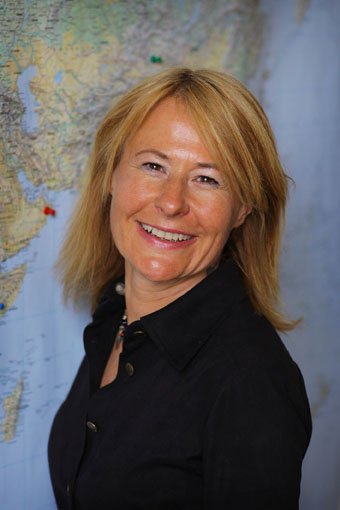
I have just submitted my copy for the “Human Planet” series book which will be published in 2011 to accompany the series. I was tasked with writing the opening chapter, which tracks the journey of Homo Sapiens across all the eight landscapes that we go to in the series. While the series is not looking at the ascent of man, this chapter gave me the chance to go back in time and really look at all the key factors that led to our unstoppable march across the whole planet.
The series looks at man’s relationship with the natural world and it was not until I got stuck into the research for this chapter that it really dawned on me just how big a part climate change has played in our phenomenal success as a species.
Just this morning on the news there was a report of an incredible archaeological find, another missing link in the chain that follows the evolutionary journey from Ape to Homo Sapiens. The main find is of a female, nicknamed “Ardi”. Just like the famous “Lucy”, this new skeleton was also found in Ethiopia, this time not in the southern Omo valley but in the far northern Afar region. This new animal is called Ardipithecus ramidus and is thought to be some 4.4 million years old and possibly a direct common ancestor of humans.
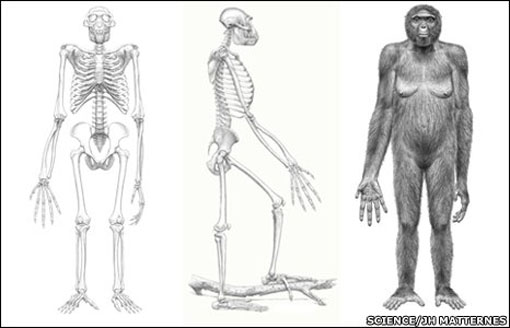
This brings me back to climate change. The American scientists who have been working at this site believe that when “Ardi” was romping around Afar she was living in a woodland area. Just like chimps today, she would have nested in the trees but she was far more bipedal than even the bonobo. Today the Afar is well known for being one of the hottest places on earth. A dry, largely barren, hostile desert, where only the hardiest of humans eke out an existence.
As the climate changed and rainforest contracted, the walking apes moved further and further into the expanding grasslands. With that, the skeletons of the early hominids evolved to cope with a land-based life. That set of circumstances also allowed our brains to develop and increase in size.
Finally modern humans evolved, some 200 thousand years ago. Here was an ape with such a big brain that it could use its intelligence to adapt and survive in every environment on earth without having to evolve into a new species (well, not so far anyway!). Antarctica is the only place that humans have not yet claimed as an official human habitat.
Every month the teams come back with incredible stories of human ingenuity, adaptation and skill from all over the Human Planet. I know we were the Ape that just got lucky, but what an incredible ape we are!
For more info on “Ardi” go to the BBC News web site http://news.bbc.co.uk/1/hi/sci/tech/8285180.stm
The Story of an I Visa
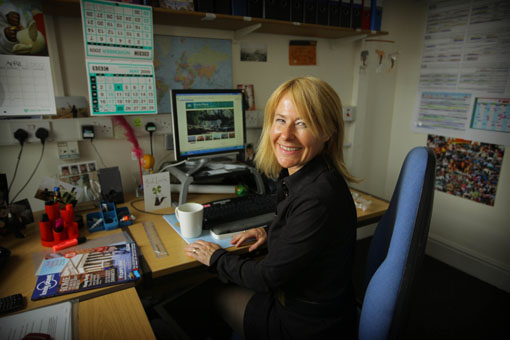
Preparing all the online forms for my I-visa
by Dale Templar, Series Producer, Human Planet
One of the things that I love about being in the USA is the first morning when I always head out for a full on American breakfast. I adore buttermilk pancakes. There is a game I play which is can you order breakfast without the waitress giving you options. Nothing is simple. Eggs are cooked and served about 10 ways, pancakes have 5 different fillings, there are at least 3 different sizes of juice, various cuts of bacon… you get the picture. It seems no matter how prepared you are there is always some thing you forget.
This week I went for breakfast at the American embassy in London. Well actually I went there to get an I-visa, the special 5 year visa you need to work as a media type in America, but I did indeed have breakfast and was nearly there for lunch and dinner too.
It used to be that you could get these visas quite easily but since 9/11 all that’s changed…..
My alarm goes off at 6.30am and by 7.30am I am dropping off all my restricted bags and mobiles at BBC Broadcasting House (BH) in London. I’d had to stay overnight so it was impossible to get my gear into the one small bag you are allowed to take into the embassy. All electronic items are banned, so I leave all communication with the office and the outside world behind. The visa rules state that everyone MUST be at the embassy at 8am to start being processed.
So there I am now standing in a very long queue outside the building, beside tents filled with hunger strikers. It starts to rain and of course I’ve left my umbrella at BH. So I stand in the queue slowly turning into a drowned rat! Finally, after 2 rain checks (get it!), I’m undercover. I’ve got as far as the scanning machine. My bag goes through once and then gets put through again. They discover I have my electronic car keys in the bag which apparently have the potential to be weapons of mass destruction. They also discover my tiny I-phone headphones - good for strangling ants maybe? So I am sent back into the rain to store them at it a local chemist.
Sometime later I am finally in the building. More queues, more waiting and I finally get to a counter. I hand over my standard BBC passport photos, nice, clear, professionally taken pictures, no strange sunglasses or weird head adornments. “Sorry, the background of your photo is grey, we need it to be white!” So I am sent away and return to the lady with my rather dreadful photo booth picture. She accepts them and now informs me that I have to wait again to be called up for the final interview.
Time for my American breakfast. A sad cup of tea and a pre-wrapped muffin. More waiting and I’m finally called up for the interview. I’m having a really nice conversation about “Human Planet” and my forthcoming polar bear shoot with the nice man, recently arrived from Arizona. He scans something and then I get “We are sorry, but some of the applications today are getting stuck somewhere between London and DC, yours seems to be one of them - it’s nothing personal but please can you go back and wait again maam!” At this point I do wonder how we ever got men on the moon.
I sit and wait and a poor Sri Lankan house keeper asks me for help. Her form will not scan for some reason. She’s been instructed to start again on the computers they have in the waiting area. The only trouble is Pauline has never used a computer in her life. She’s such a precious person. Both her parents died when she was three and she grew up in a convent. Her employer had filled out the form and sent her to London for the first time by herself.
This took a while - the computer kept skipping back to the front page, but the conversation somehow transported me into another world. The form successfully prints and I snap back into the challenge of getting my own I-visa. I finally take things into my own hands and dare to go to one of the interview booths, without my number being called and plead for mercy. The man kindly finishes off the process and informs me that unless DC have any problems, which he doubts, my passport will be returned to me with an I-visa in about three days. THE END (I HOPE). GOD BLESS AMERICA!
The next day I am informed that we may move the story to Canada rather than Alaska!
Teams everywhere on location
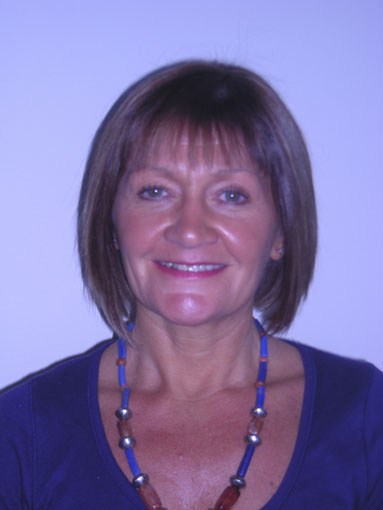
by Ellen Davies, Production Manager, Arctic/Mountains team
My location is Cardiff and my office is on the top floor of BBC Wales which overlooks Llandaff Cathedral. Here I enjoy the comforts of my work place where so many of our day to day facilities are taken for granted. I’m comfortable. One of my teams are currently in Greenland, the other is about to head off to Mongolia (for more see below my blog). Geoff from BBC Shipping has a very soft, gentle voice and says: “Calm. Calm.” It works. I’m now calmer and I’m in the process of freighting my second shipment of kit to Qaanaaq, the most northern town in Greenland. Geoff simplifies the process.
We hire, purchase, gather and pack our kit with our wonderful Patrick Murray, Cardiff’s Technical Assistant on Human Planet (what would we do without Patrick?). For Greenland this includes a crane with hothead, a kayak with specially designed rig, camping gear, cameras, sound, first aid kit and enough warm clothes and sleeping bags to make sure the crew don’t freeze.
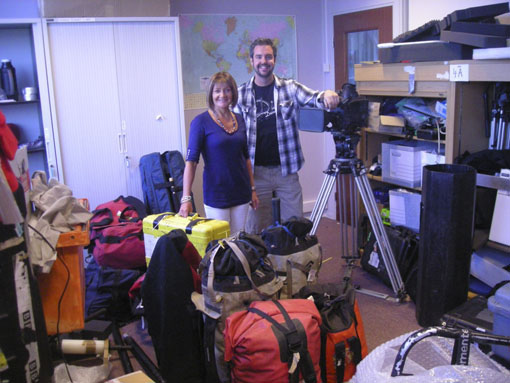
Ellen and Patrick and kit bound for the Arctic
Getting the kit to our destination is quite straightforward – from Heathrow to Copenhagen to Kangerlussuaq to Illulissat to Pituffik to Qaanaaq and onto Siorapualuk. Easy. (I can even pronounce these names now!) The kit gets there. It takes two days. The last ride is by helicopter where you would fly along the rocky coast line over icebergs and fiords. It must be pretty spectacular. The third shipment of kit travels with the crew and I’ve only booked a seven seater people carrier to transport three people and kit! Where and how do we accumulate so much? We’ve now exceeded over 1000 kgs of kit. The Arctic crew are out of the door and I’m already on the next shoot for the Mountains programme….
My Greenland team are filming two stories for the Arctic episode and one involves filming on sea ice that is starting the break up. Because of the dangers of trying to film the narwhals (sea unicorns) from the kayak and on the ice edge, we have a strict protocol – Bethan Evans (researcher) or Nicolas Brown (producer/director) must call me at 16.00 hrs daily. If I don’t hear from them after four hours, I then make contact to their local police. I look forward to my cup of tea after I’ve received their phone call. I can relax for another day. My schedule and two mobile phones rest on my bed side table and I warn my husband that I might just get a call. I put my phones on silent but vibrate.
Sometimes I wish I was the one going on these amazing filming trips but generally I enjoy being on the end of a satellite phone, the welcome voice of home for the guys on location. By working on this series I’ve really come to understand the incredible way people live in these remote environments. More than ever I appreciate the comforts of my home, my family and friends and the BBC office. Roll on 2011, when I will enjoy watching the fantastic footage and amazing stories on my 52” plasma screen in HD!
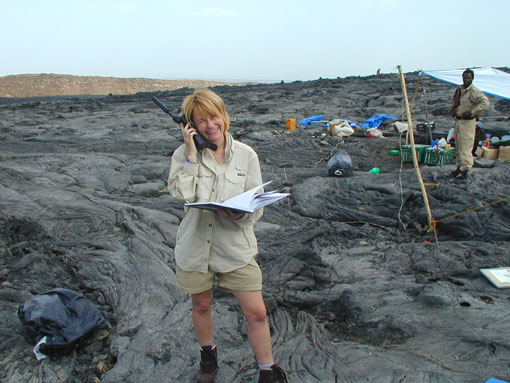
Dale Templar, Series Producer, A Return to the Last Disco in Mongolia
I don’t get out much these days, one of the few down sides of running Human Planet. On Sunday I am due to return to Mongolia to film golden eagle nests. I say “due” because I’ve just had a phone call from Dina, our researcher, to say the eagle chicks we wanted to film have been taken! Poor Dina! As I write, there are men on horses galloping around the western Mongolia mountains looking for eagle nests. They are seven hours ahead and if there is no joy soon we may have to cancel the shoot.
Anyway, back to my original story. If we do fly on Sunday this will be a strange return. The last time I filmed in Mongolia was in 1993, soon after Russia pulled out of the country. It ‘s still one of the most God forsaken places I have ever visited. The economic rug had been pulled from underneath the country - they’d been left abandoned. Ulaanbaator was a sad, bleak capital city filled with stark Stalinist buildings, empty shops, abandoned hospitals and truly disgusting food. No longer needed as a buffer zone with China, they’d been left to start again.
I had gone to make a film with Fergal Keane about the sewer children and spent a fair bit of time underneath the rat ridden streets of the capital. We had knives pulled on us, stones thrown at us, sewer covers slammed on us……. umm Mongolia, can’t wait to return. Thank goodness for the disco at the Ulaanbaatar Hotel !
Seventeen years on, I’m told Mongolia has changed significantly. I actually can’t wait to see it. The boy I filmed was called Batzayan, he will now be a man. Hopefully he will be successfully forging his way, feeding his children and keeping them warm as this now established democracy pushes open the doors of the market economy.
It’s a Small Small World…
by Nicolas Brown, Producer/Director, Arctic and Mountains
“Is one of you Mr. Brown?”
Shock, blood rushes to my face. “Who knows me here? This is the most remote airport I have ever been to. (Have I done something wrong…?)”
We are in Ummannaq, which is nearly 600 km North of the Polar Circle, halfway up the West Coast of Greenland. The town sits on a tiny island (12 sq km) dominated by a towering rock called “Hjertefjeldet”, or Heart–shaped Mountain. It is easily the most picturesque fishing village I have ever seen - and the most far flung.
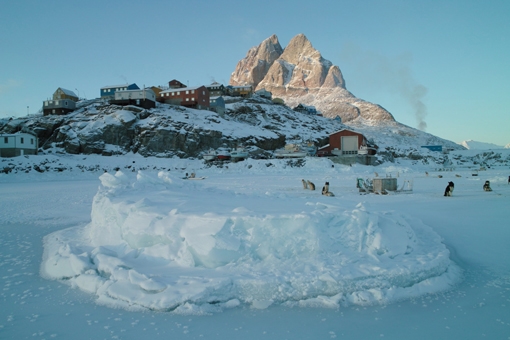
Ummannaq and Hjertefjeldet
The woman in front of me laughs at my bewildered look. “My husband is Ole Jørgen Hammeken. He is friends with your father.”
Soon I am seated across from Ole Jørgen — the man my father calls “The Eskimo Errol Flynn”. The comparison is apt. Ole Jørgen has a stage presence that fills a room. A decade ago, he led my father on an expedition to the northernmost mountain in Greenland, now dubbed Hammeken Point. Ole is the first native Greenlander to be honoured as one the world’s elite explorers.
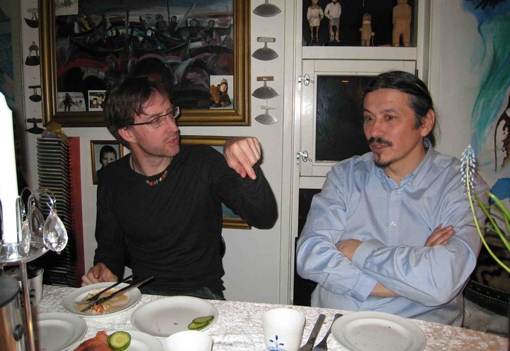
I'm on the left, Ole Jorgen on the right
We laugh at the coincidence — Ole has been to my home thousands of miles away in Gypsum, Colorado, in the heart of the American Rockies. There he ate venison that we harvested from the forest behind our house. Now, totally unplanned, I am seated at his table, eating halibut harvested that morning from beneath the Ummannaq sea ice.
Weeks later, Human Planet takes us to Nepal. It is another place I have never been. Once again, I am greeted with a shock.
“You look like your brother…” muses a Nepali man standing before me. “But he is a strong climber—strong as a Sherpa. Are you?”
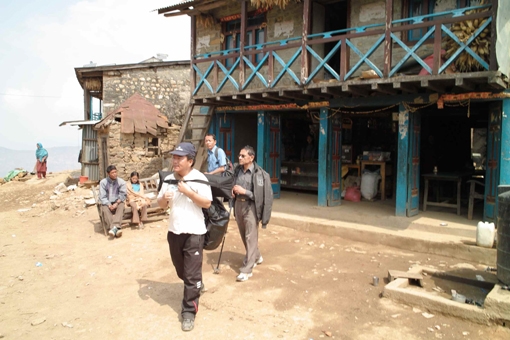
Pemma Sherpa
I stare into the beaming, mischievous smile so characteristic of Nepali Sherpas. A flash of recognition hits me. Put goggles on his eyes, an oxygen mask on his face—yes, it is Pemma Sherpa, who led my brother to the top of Mt. Everest last year. I’ve seen the pictures (it was my brother, Michael Brown’s, fourth successful summit).
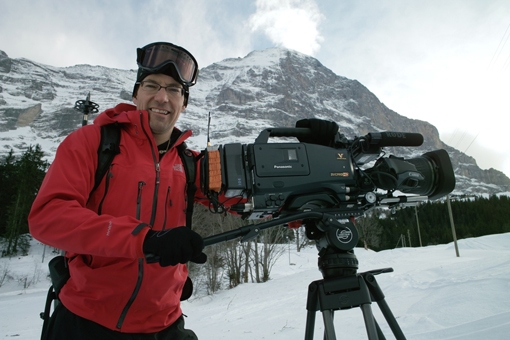
Michael Brown
I can tell that Pemma is going to push me. I’m not the mountaineer my brother is. I curse myself for not training harder for the expedition ahead…
When I started work on Human Planet I knew we would be exploring places I’ve never been before. But I never expected to keep bumping into people I know! In the famous words of my fellow countryman Walt Disney, “It’s a small, small world!”
Dale Templar, Series Producer - Icebreakers
Last week we had unfermented mud in Mali stopping a shoot, this week we’ve had sea ice breaking up far too fast in Greenland. Pushing complex filming trips back at the last minute is not ideal but bringing them forward can be a total nightmare and that’s exactly what it has been. Whether or not you believe the global warming theories, things ain’t what they used to be in the Arctic. One morning last week our “Queen of the Ice”, Bethan Evans got the call she never wanted from North-East Greenland. Overnight a big storm had come across the region and many kilometres of sea ice had been literally blown away - the team had to come and film “now!”, not in four weeks time as planned. With director Nick Brown away in Nepal (see above), the camera crew and safety co-ordinator booked to work elsewhere and flights every two weeks at best, we were starting from scratch. Willow Murton, our assistant producer had to drop the other story she was working on in Siberia and it was Arctic action stations. Somehow, I do not know how , we have an amazing team on location with one of the world’s top Arctic cameramen, Doug Allan. He had another shoot pencilled in for the series Frozen Planet that got cancelled due to weather! How lucky was that?
Welcome to Human Planet
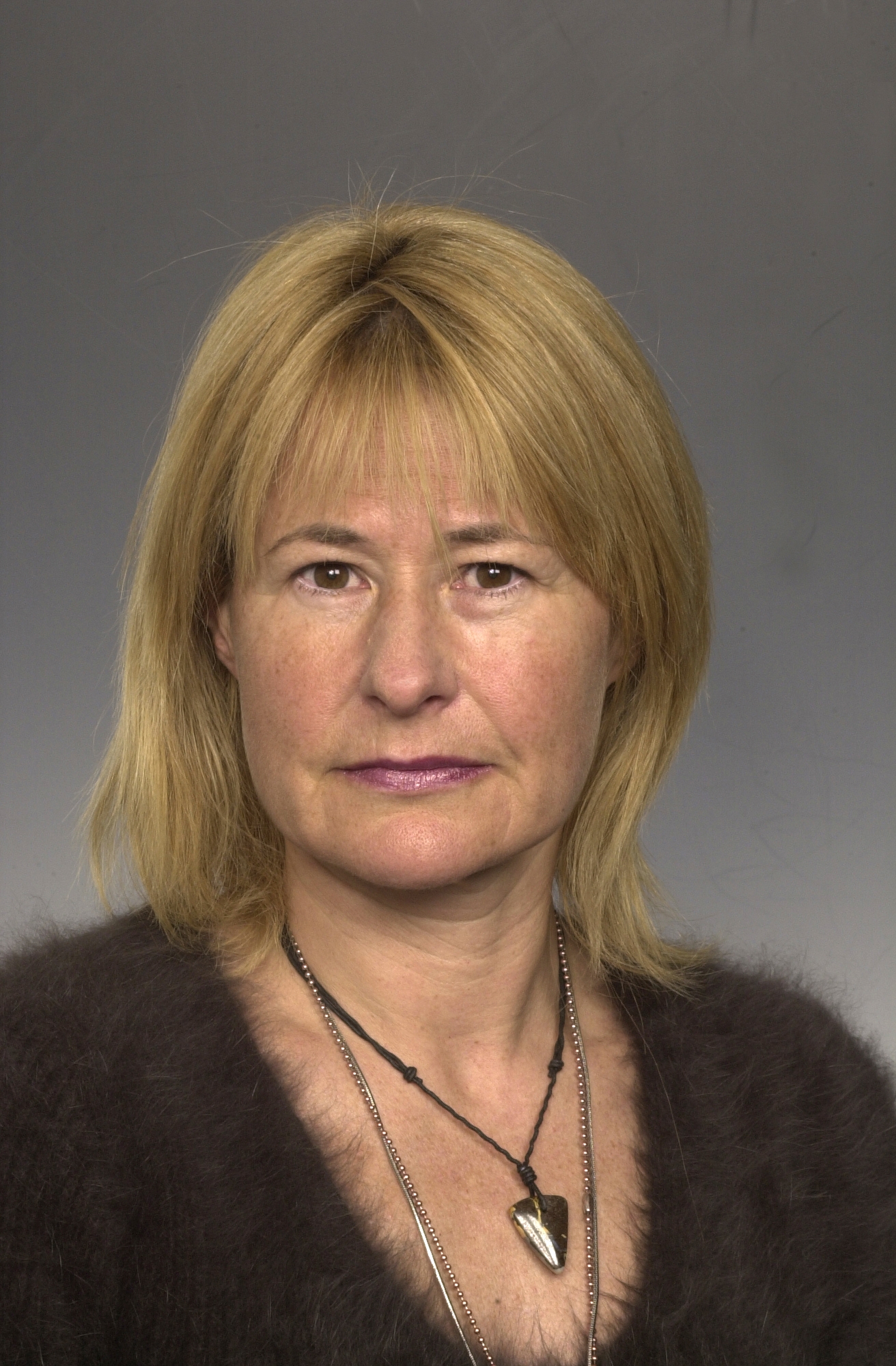
Dale Templar, Series Producer
by Dale Templar, Series Producer
So what is Human Planet? Human Planet is a new 8×50 minute landmark documentary series being made by BBC Television. The series celebrates the human species and looks at our relationship with the natural world by showing the remarkable ways we have adapted to life in every environment on earth. It is due to be transmitted in the UK in the New Year 2011 and will be rolled out across the world soon after.
The production team is split across two sites, one in Bristol and one in Cardiff.
In BBC Bristol we are part of the world renowned Natural History Unit. You may have heard of us, but if not, you’ve probably watched some of our programmes. Many have been presented or narrated by Sir David Attenborough, like Planet Earth and Blue Planet. Most recently we’ve just finished Nature’s Great Events which our own executive producer, Brian Leith, worked on.
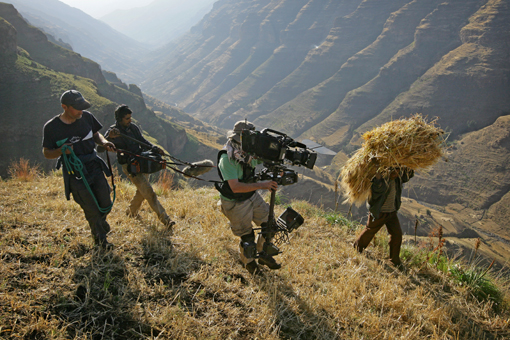
BBC Human Planet : Simien Mountains
BBC Wales, based in Cardiff, are probably best known in the UK right now for producing high end popular dramas like Doctor Who. Torchwood, another sci-fi doc that comes out of Cardiff, is also an HD production and Human Planet will be using the same excellent post-production facilities. The factual department is best known for its ground-breaking anthropology documentary series Tribe.
In total we have a core team of 20 phenomenally talented programme makers, who come with a wide range of skills and experiences. Working with us are some of the best wildlife and documentary camera crews and fixers in the world. For the first time we have a dedicated stills photographer, Timothy Allen, who will be posting his own Human Planet blog every week at http://timothyallen.blogs.bbcearth.com/
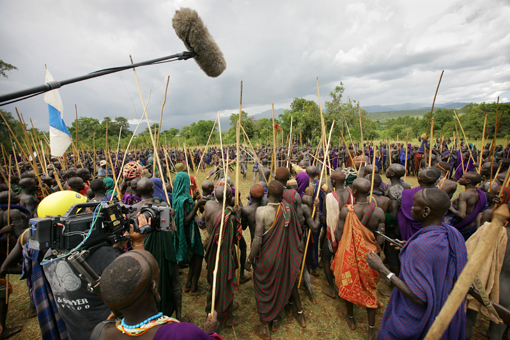
BBC Human Planet : Suri stick fight
The series started in full production in the summer of 2008 and we will be shooting over 70 stories in some of the most remote locations on earth in around 40 different countries.
Each episode will focus on one single environment: desert, jungles, arctic, grasslands, rivers, mountains, oceans and urban. Many of the stories are extremely dramatic and will show how we have successfully adapted and survived in the most challenging places on the planet.
As from next week each member of the team will be blogging their stories from the Human Planet. I will keep you updated on where everyone is and give you general news about the series.
Currently, we have teams that have just come back from the remote southern region of Mongolia, filming for the desert episode. On location are the Jungles and Mountains team who are in the Central African Republic and Nepal. I’ll let you work out which team is where!
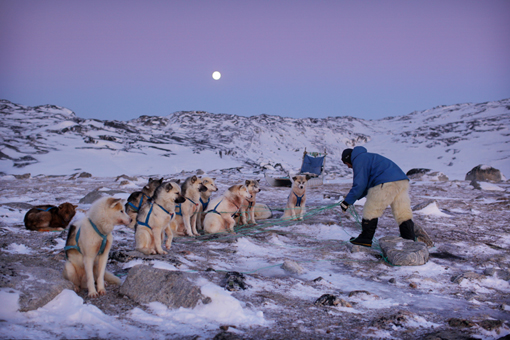
BBC Human Planet : Arctic Dawn
That’s it for now …enjoy the photos and the sneak preview from the series. See the link if you’d like to read what Timothy Allen’s been up to and don’t forget to explore the new BBC Earth site too. Look out for the regular Friday posting from the Human Planet team, with fascinating stories and tales from both our many locations and from the office.
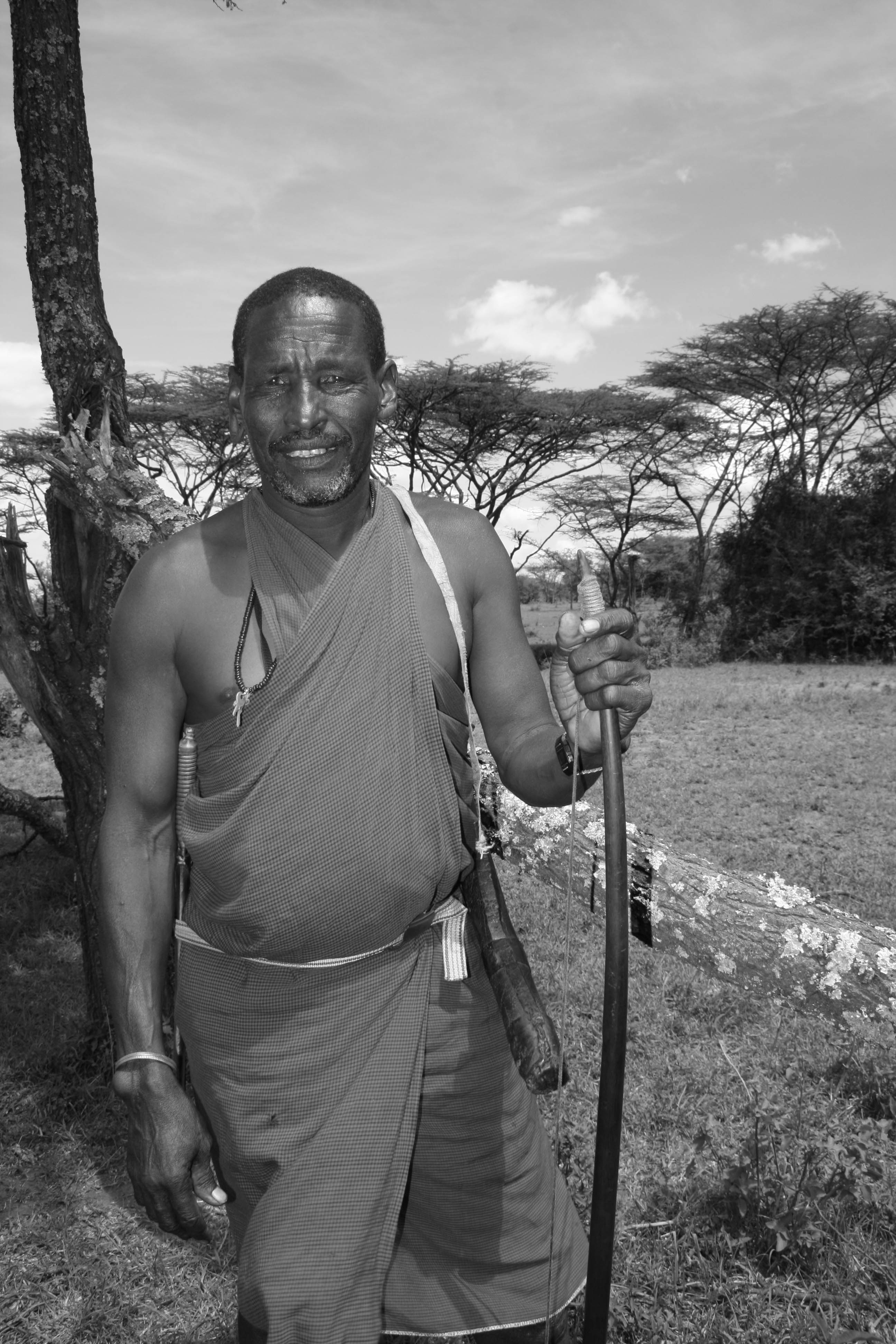

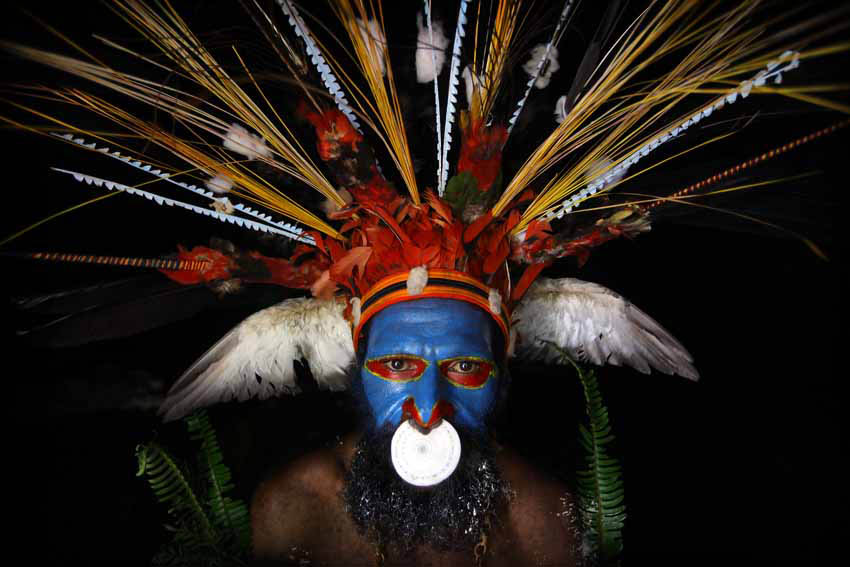
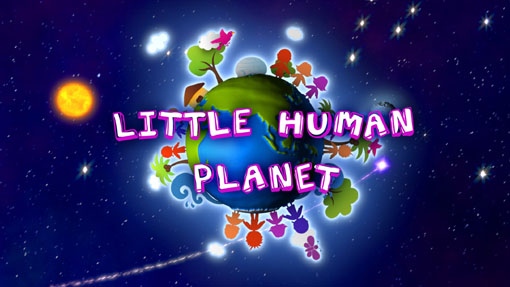
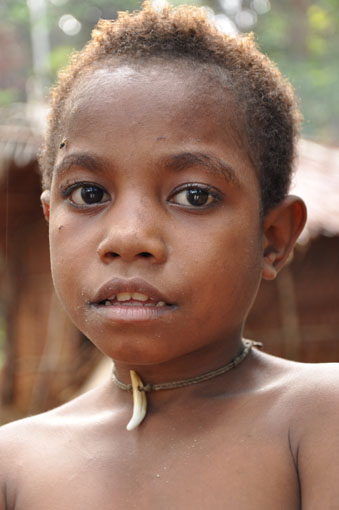
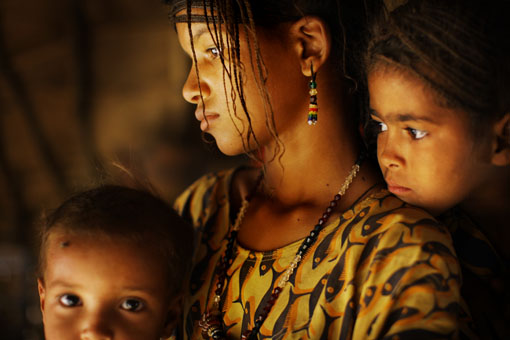
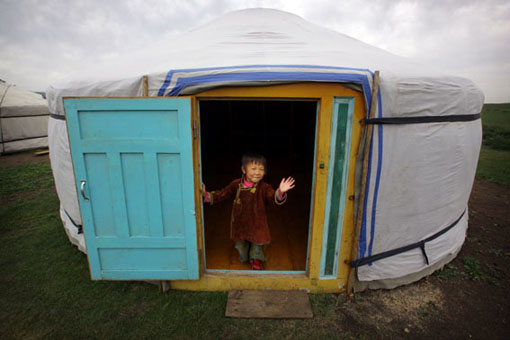
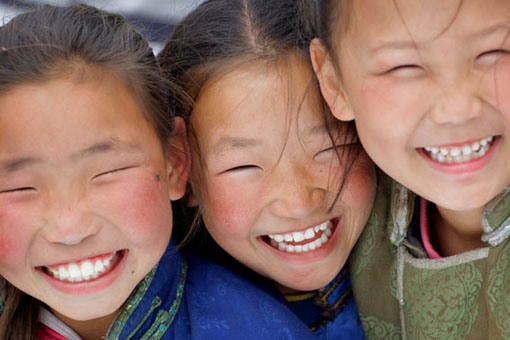
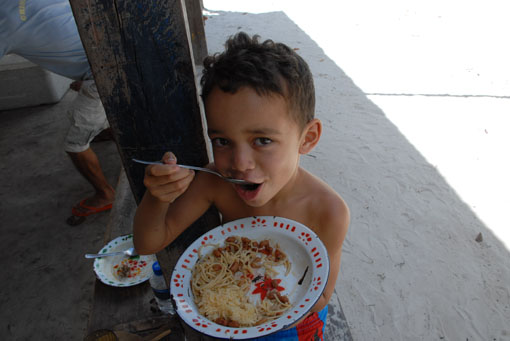
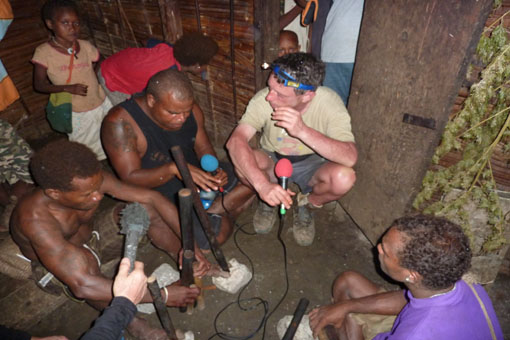
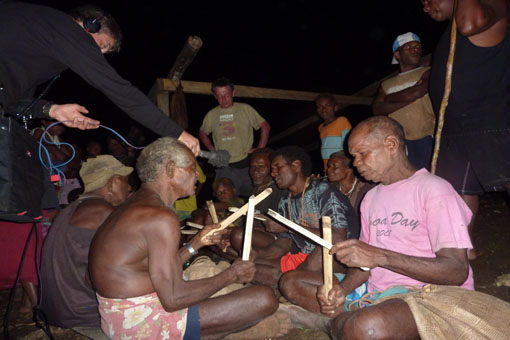
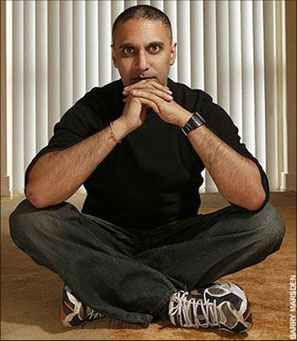
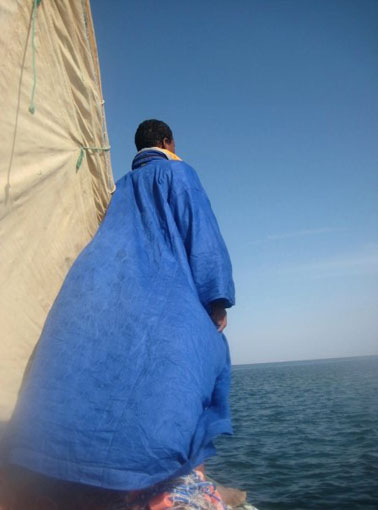
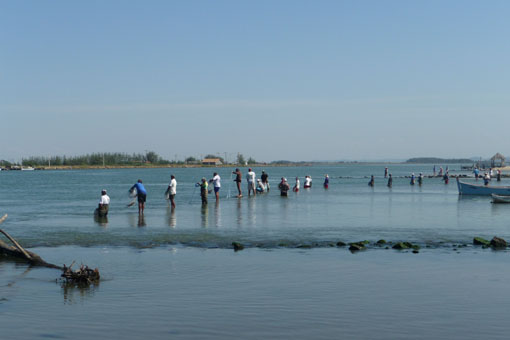
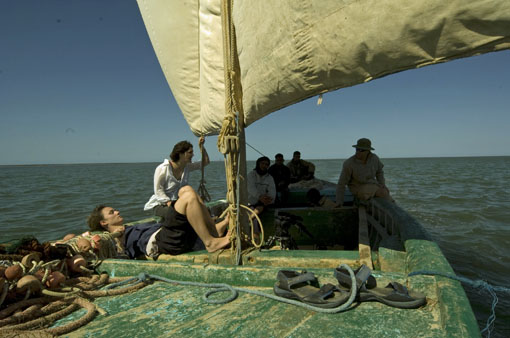
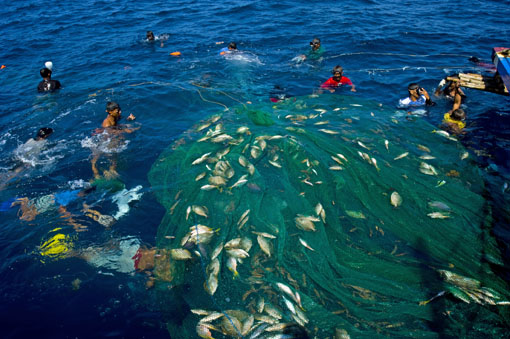
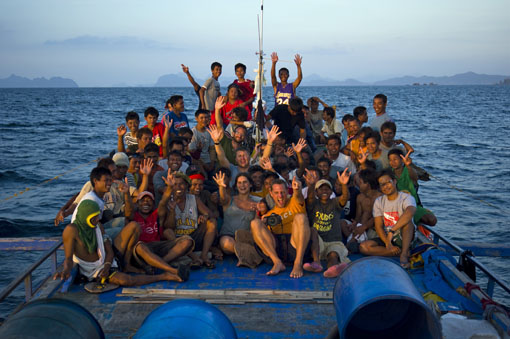
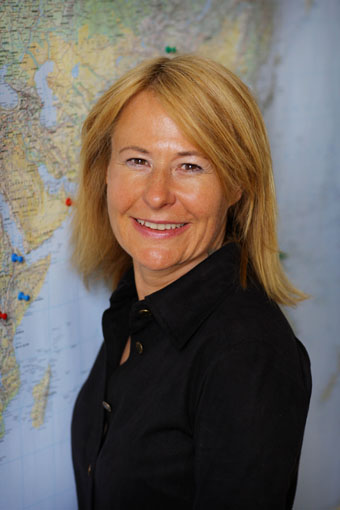
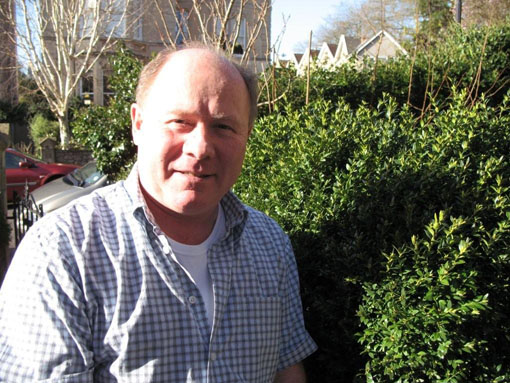
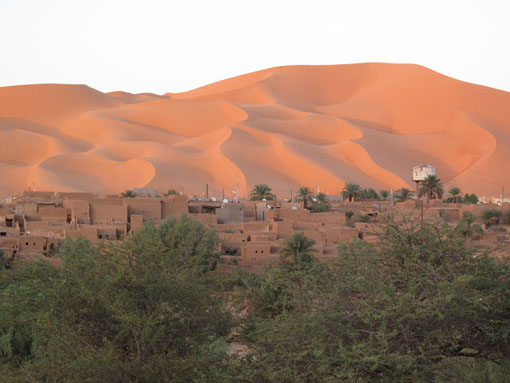
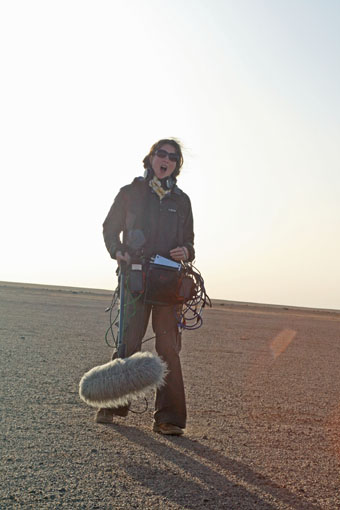

Mr. Hurt, I Presume?
by Dale Templar, Series Producer
John Hurt
When you’ve worked in television for over 20 years you get quite used to meeting and working with famous people. There are very few encounters that have ever really fazed me. One exception was meeting George Michael in a studio at the height of his solo career in the early 90s and, more recently, literally bumping into David Beckham behind the scenes at the O2 in London, with a beefburger in my mouth.
Well, a few weeks ago I was in another recording studio in Hampstead, North London waiting to meet one of our most truly talented British actors. I spotted him as he came through the door of the studio canteen and, as I walked towards him, a vast array of movies and characters flashed before me. Here was “The Elephant Man”, ” The Naked Civil Servant”, Harry Potter’s eccentric wandmaker and finally that stomach bursting scene from “Alien” leapt into my mind! Yes, it can now be officially confirmed that John Hurt is the voice of “Human Planet”. And what a voice! As soon as he shook my hand and said a simple “Hello, nice to meet you”, I just couldn’t wait to start our voice record session.
We spend months in edit cutting the pictures, crafting the films visually but we listen to the programmes with what we call scratch voices on them. At this stage, the script is usually recorded by the episode producer or, sometimes, the picture editor. They always do a great job but when the script is finally locked and we finally get to put on “the voice of the series”, a instant transformation occurs. The narrator gives it a unique identity. John’s resonant, commanding yet warm voice wraps itself around the pictures and draws you into the action and the characters. As I expected John was a consummate professional and we all worked incredibly hard, recording the voice-over for both the Arctic and Oceans episode. This is not an exact science but every line, every word is scrutinized. John had six sets of professional ears, including his own (which was usually the most critical), making sure everything was perfect.
What I loved was John’s dry sense of humour. In the Arctic script we do a scene which is effectively written as a pastiche of a television cookery show, of which we have many in the UK. Here was John Hurt doing his own wonderful interpretation of Delia Smith, or one of that ilk, reading out a recipe for how to prepare Kiviak, a Greenland delicacy, made from unplucked Arctic birds and a sealskin. A classic moment I will never forget.
Aug 20, 2010 | Categories: On Location | Tags: arctic, BBC; Human Planet;, commentary, Dale Templar, Greenland, John Hurt, Kiviak, narrator, oceans | Comments Off